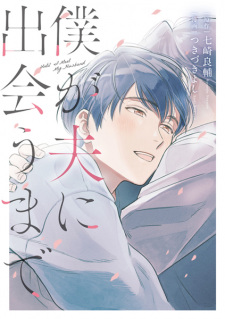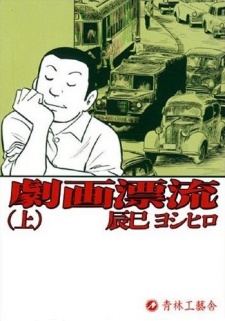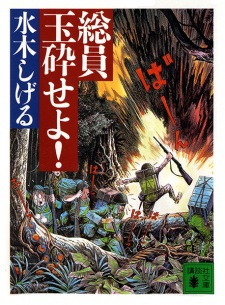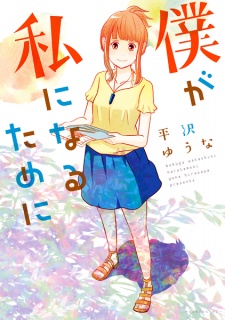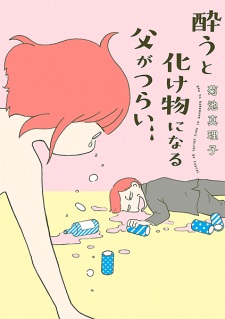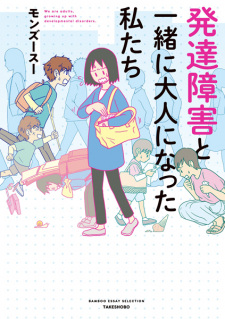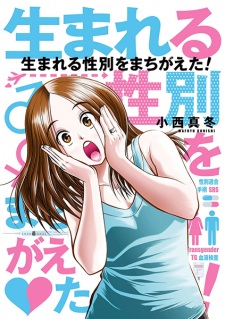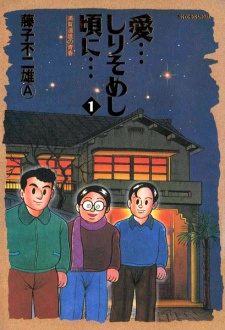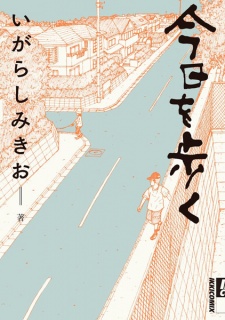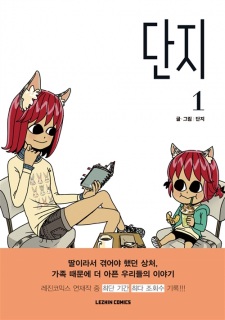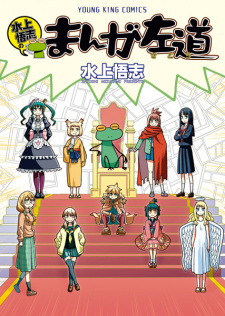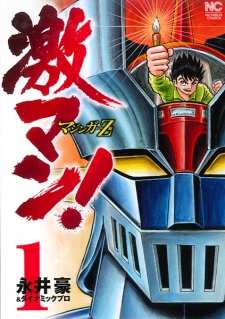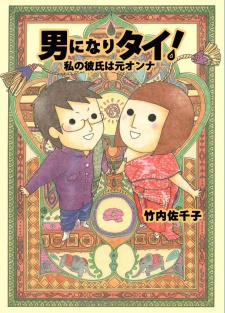- All
- Not In My List
- Reading
- Completed
- On-Hold
- Dropped
- Plan to Read
Members
Score
Newest
Title
Volume
After her life takes a turn for worse shortly after dropping out of college, Kabi Nagata becomes depressed and develops an eating disorder. She feels immense pressure from her family to be a "normal" and productive person, along with an acute desire to belong to a community. Despite attempts to solve these problems, she struggles to resolve her pain, and her situation worsens. At 28 years old, Kabi contacts a lesbian escort service. She imagines this event as a rite of passage into adulthood she has been avoiding for so long. And while this experience does not turn out to be exactly what she was expecting, it proves critical to Kabi's reimagining of her life. [Written by MAL Rewrite]
Akiko Hayashi has soaring but strangely specific dreams: to make a successful manga debut while still in school, have her favorite actor star in its adaptation, and end up marrying him. However, she is far from having the motivation or skills to realize these hopes. When a friend introduces her to an unorthodox, backstreet art class taught by the strong-armed Kenzou Hidaka, called simply as "sensei," Akiko decides to enroll, expecting an easy ride and an automatic improvement in her art skills. To her chagrin, what she gets is something else entirely—a tough, demanding, and uncompromising teacher with absolutely no interest in manga. But when Akiko takes up Sensei's challenge of an intense schedule, she comes to recognize how much he cares about his students and forms a close bond with him. With Sensei's guidance, Akiko learns what is necessary to become a successful mangaka as well as what it means to be an adult. [Written by MAL Rewrite]
Famed horror manga artist Junji Itou loves nothing more than to stand and admire the fresh white wallpaper, gleaming floors, and smell of his brand-new house. But his happiness is short-lived when his fiancée, A-ko, reminds him of her plan to bring her cat Yon into their new abode. As an avid dog person, Junji experiences chills down his spine whenever he recalls Yon's uncanny face and a seeming skull on his furry coat. When A-ko also decides to adopt another cat, Muu, to keep Yon company, he fears that all hell will break loose. With Yon and Muu's arrival, the wallpaper is quickly covered in shiny, protective sheets; the floor is marred with scratches; and the stench of the litter box hangs heavy in the air. The two cats become quick friends, and—to Junji's surprise—endear themselves to the new cat owner as well. As they grow closer, the manga artist begins to believe that living with cats may not be so bad after all. [Written by MAL Rewrite]
Jealous of other people successfully moving forward in life and constantly eaten away by her insecurities, Kabi Nagata finally musters the courage to leave her parents and move into a new apartment alone. Unfortunately, she struggles to adapt to this new lifestyle and begins to contemplate her newfound feelings of loneliness, including her estranged relationship with her mother and what it means to love and be loved. As the psychological pressure mounts, her resolve waivers. From her family to love, Nagata attempts to overcome her tumultuous past and heal the wounds that afflict her. No matter how broken she may be, she does her best to move forward. [Written by MAL Rewrite] Included one-shot: Volume 2: Chika-chan no Yuuutsu
Chii and her husband are like any other happily married couple, except for one thing: Chii was assigned male at birth. Chii details her autobiographical account of growing up with gender dysphoria and ultimately deciding to transition in her early adult years. Shortly after Chii starts transitioning, she meets a man who is instantly enamored by her, and although he is surprised when Chii eventually tells him she used to live as a guy, he still wants to go out with her. As Chii continues to transition, her boyfriend supports her through the process, culminating in their marriage once her transition is complete. (Source: Hachimitsu Scans)
On October 10, 2016, Ryousuke Nanasaki married the love of his life, Ryousuke. But the time leading up to this day was anything but easy. Feelings of self-hatred, heart-wrenching breakups, and coming out to his family—it was all an uphill battle. Based on the autobiographical web essay of the same title, Boku ga Otto ni Deau made follows Nanasaki's life and his journey to discover a happy ending together with his husband. [Written by MAL Rewrite]
Kabi Nagata's downward spiral is getting out of control, and she can't stop drinking to soothe the ache of reality. After suffering from unbearable stomach pains, she goes to a clinic, where she is diagnosed with pancreatitis—and is immediately hospitalized. A new chapter unfolds in Kabi Nagata's life as she struggles to find her way back to reality and manga creation in the wake of her breakdown. (Source: Seven Seas Entertainment)
Over four decades ago, Yoshihiro Tatsumi expanded the horizons of comics storytelling by using the visual language of manga to tell gritty, literary stories about the private lives of everyday people. He has been called "the grandfather of Japanese alternative comics" and has influenced generations of cartoonists around the world. Now the visionary creator of "The Push Man and Other Stories" and "Good-bye" has turned his incisive, unflinching gaze upon himself. Over ten years in the making, "A Drifting Life" is Tatsumis' most ambitious, personal, and heart felt work: an autobiographical bildungsroman in comics form. Using his life long obsession with comics as a frame work, Tatsumi weaves a complex story that encompasses family dynamics, Japanese culture and history, first love, the intricacies of the manga industry, and most importantly, what it means to be an artist. Alternately humorous, enlightening, and haunting, this is the masterful summartion of a fascinating life and a historic career. (Source: Drawn & Quarterly)
Honda is a skeleton, but more importantly, she is a bookseller. And she'll tell you from firsthand experience that the job of a bookstore employee is more challenging than it may seem to the average customer. Alongside her equally eccentric coworkers, Honda constantly deals with the stressful requirements of the bookselling industry. From the drama of receiving new titles without their bonus material to the struggle of providing quality service to customers who speak a different language, the work of a skeleton bookseller never ends. Nevertheless, despite the hardships she faces, Honda thoroughly enjoys her job and strives to bring the best book selections and service to her customers. [Written by MAL Rewrite]
Souin Gyokusai seyo! is a "semi-autobiographical account of the desperate final weeks of a Japanese infantry unit at the end of World War II." Mizuki drew from his own experiences as a soldier in that war to depict the horrors of battle. On an island at the end of 1943, Japanese soldiers are obliged to commit suicide in order to save the honor of their country. (Source: ANN, bdangouleme.com)
Hideo Azuma was born 6th February 1950 in Hokkaido. He moved to Tokyo where he was assistant to Rentaro Itai and debuted in manga in 1969. Throughout the 70´s and 80´s he produced a large body of work in many genres including the comedies FUTARI TO GONIN (Two People and Five) and YAKEKUSO TENSHI (Desperate Angel), the Science Fiction Seiun (Japanese Hugo) Award winning FUJOURI NIKKI (Absurd Diary) and is also known as the father of Lolicon manga. But the pressures told and, in 1989, he ran away from his responsibilities and went homeless. After this experience and his eventual return to normal life, he then repeated the cycle in 1992, this time becoming a gas pipe layer in another town. Later, in 1998, his alcoholism was so bad that he was forced into rehab. This book is his expression of those three periods of his life told, not in a deep or depressed way but, as befits his nature, in a buoyant and cheerful cartoon art and is a welcome addition to the "personal manga" genre. In 2005, SHISSOU NIKKI (Disappearance Diary) was awarded the Grand Prize from the 9th Japan Media Arts Festival Manga Division and the Excellence Price at the 34th Japan Cartoonists Association Awards. (Source: ANN)
The manga is based on a dramatic tragedy diary written by Aya Kito, published shortly before her death. The diary, a true story based on her own life, was originally written in first person. It is about a girl coping with her teenage life along with a degenerative disease. She keeps a diary of not only what she does but how she feels and the hardships she must endure. Initially, the diary's purpose was for Kito to chronicle impressions she had about how the disease was affecting her daily life. As the disease progressed, however, the diary became Kito's outlet for describing the intense personal struggles she underwent in coping, adapting, and ultimately trying to survive her disease. As she notes in one entry, "I write because writing is evidence that I am still alive." (Source: Wikipedia)
My Kitty and Old Dog is a collection of short, heartwarming, and episodic stories that describe the relationships between the old poodle Nang-nak, the cute kitten Soondae, and their loving owners. Some stories are autobiographical—telling the artist's own experience with his pets—while others are told from the pets' point of view in an interesting, fresh, and innocent take on storytelling. [Written by MAL Rewrite]
A historical story using Ghosts to explain the life times of the reign of Emperor Hirohito. Comic Showa-shi describes an era of upheaval and impoverishment in Japanese history, beginning with the Tokyo Earthquake in 1923, and covering the financial panic, the Great Depression, the March 15th Incident, and other events up until the Manchurian Incident in 1931. (Source: Volume 1 cover)
Autobiographical essay manga from Kabi Nagata surrounding her struggles with her eating disorder and binge-eating.
Porn actress Nazuna Nonohara looks back on the tragic life that has led her to where she is today. She discusses the hardships she has faced in her domestic life—specifically the sexual assault she faced at a young age at the hands of her stepfather, and the time her older brother raped her. The impact of these horrific events has left Nazuna androphobic—terrified of men. Dansei Kyoufushou Datta Watashi ga AV Joyuu ni Naru made no Hanashi is a true story based on the experiences of the mangaka, who shares a name with the main character. [Written by MAL Rewrite]
The experiences of author, Tatsuta Kazuto, a former laborer at the Fukushima I Nuclear Power Plant after the March 2011 earthquake and tsunami.
After graduating university, Yuuna spent several years going through the motions and working an office job. Until one day, while in pursuit of an essential missing piece of her life, she receives a diagnosis of gender dysphoria, which opens up new doors for her. As she takes on medical treatments and tries out new makeup and outfits, she sees just how lonely and difficult the process of transitioning can be. But in 2015, when Yuuna travels to Thailand for her gender-affirming surgery, the support of her siblings, new strangers, and documenting her experience through manga helps her begin to heal in more ways than one. Told in an honest and, at times, humorous tone, this memoir is a blend of manga and detailed prose that does not shy away from sensitive topics, such as suicidal ideation, transphobia, and the simultaneously harrowing, yet joyous, experience of gender-affirming surgery. (Source: Kodansha USA)
In this story set in the early 1980s, a young man dreams of becoming a renowned comic writer in years to come. His name is Honoo Moyuru. He has no money, only a dream. Then, he feels overwhelmed by his lack of ability, and buys some sake, although he has no head or stomach for alcohol. This is a tortured elegy for any dashing young art student who spends his days careening around in burning ambition.
Mizuki takes another chapter from his life to create Nonnonbaa, a story about a boy in the 1930s who is introduced to the world of Japanese folklore by a old neighbor woman. (Source: ANN)
Honey & Honey is a realistic look at an adult lesbian couple living in Japan; to be precise, it's autobiographical. The artwork is simple, but hopefully the plot (and the information the manga imparts) will be enough compensation for those who don't like that style of drawing. This manga is similar to Plica, though it's not a 4-panel manga. (Source: Lililicious)
In this new autobiographical manga following My Wandering Warrior Existence, Kabi Nagata has quit drinking in an attempt to get healthier—or she's trying to, anyway. Her former struggles with alcohol led to pancreatitis and a serious hospitalization, and now she has no choice but to give it up. Follow the author as she details the quest to improve her health during a global pandemic. (Source: Seven Seas Entertainment)
This autobiographical essay manga centers on Moyoco Anno's married life with her husband, director Hideaki Anno (Neon Genesis Evangelion). The comedic and heartwarming book follows their "otaku lifestyle" and also features an "otaku glossary" with 20,000 words. (Source: MU)
Mariko Kikuchi tells the painful story of her father's alcoholism and her own journey through guilt to understanding her father's illness. She rejects the common belief that family members can and should be forgiven for anything they do, no matter how much harm they cause. This powerful, self-contained autobiographical manga began as a web series that went viral, and inspired a critically acclaimed 2019 film in Japan. (Source: Seven Seas Entertainment)
This intimate manga anthology is about the struggles and triumphs of individuals learning to navigate daily life with a developmental disorder. The comics follow the stories of nine people, including: a junior high dropout finding an alternate path to education; a former "troublesome" child helping kids at a support school; a so-called problem child realizing the beauty of his own unique quirks; and a man falling in love with the world with the help of a new medication. This inspiring volume illustrates their diverse anxieties and finding self-empowerment in a world not quite built with them in mind. (Source: Seven Seas Entertainment)
Autobiographical essay describing the process of becoming a female from male. Konishi Mafuyu, who had been diagnosed with GID (Gender Identity Disorder), tells her real experiences on her journey to Thailand to receive a SRS (Sex Reassignment Surgery) in order to become a woman in soul and body. (Source: ElPsyCongroo)
(No synopsis yet.)
A humorous and insightful autobiography by Hiromu Arakawa, recording her daily life as a dairy farmer in her homeland Hokkaidou before becoming a manga artist. "If there's no water, let them drink cow milk," the Commoner Noble proudly said.
Manga artists Ayami Kazama and Azure Konno are married, and, just like many other couples, they are thinking about starting a family. However, devastating news brings their plans to a halt: Ayami's body does not ovulate, leaving her infertile. Determined to have a child with Azure, Ayami begins the long and grueling process of fertility treatment to eventually become pregnant. From the uncomfortable medical appointments to the mystifying changes her body is undergoing, Ayami is pushed out of her comfort zone—but her conviction helps her persevere through multiple challenges along the way. [Written by MAL Rewrite]
Former porn star turned author Ooshima Kaoru details his autobiographical account of his daily life as a pansexual cross-dresser and what led him into working in the adult film industry. Along the way, he meets another porn star similar to him who he calls Michelle and the two start dating. (Source: Hachimitsu Scans)
A semi-autobiographical manga depicting the daily lives of a husband, his tsundere wife and their two sons.
This is a semi-autobiographical story of manga author Kazuichi Hanawa's time when he was taken in for a violation of bearing of arms. The main character really loves to collect guns, what can he to do about this? Nothing, really. He cant help it even if he is living in a country where its illegal to own any. All he can do is to continue his hobby and hope that nothing goes wrong. Well, it did go wrong and we follow his experience in prison. (Source: koufukuron.com)
An autobiographical manga about Paru Itagaki, her two older sisters, mother, and father. (Source: MU)
A diary of my sexual awakening...at thirty-three?!! Asuka is neither a woman nor a man—they're X-gender (a non-binary identity)—and they've realized they like women! Okay, now what? Adult films are fun to watch, but real sex is less appealing. Would having a penis make that better or worse? Periods already suck, and sex means more fluids from more people! This autobiographical manga follows Asuka's feelings about their body, their relationships, and the fun (and sometimes terrible) experience of having an awakening in their thirties. (Source: Seven Seas Entertainment)
A heartwarming autobiographical comic offering a peek into the daily life of Ayu Inui and her girlfriend, Kon-san.
Mangaka Kouji Mori remembers about his life with his deceased best friend.
The last thing that 38-year-old erotic manga artist Hilnama expects is to be diagnosed with terminal stage IV colon cancer. Although her health seemed fine at first, a bad bout of what seems like period cramps convinces her to visit the hospital, where the doctors discover a mass obstructing her colon. With almost no time to process the news, Hilnama undergoes surgery and subsequently begins chemotherapy. Despite facing such adversity, she never loses hope and manages to maintain a cool head in the face of her grim diagnosis. [Written by MAL Rewrite]
There is a Japanese saying that goes, "Hana yori dango," or "dumplings over flowers." And no one is more of an advocate of this adage than mangaka Y-naga, a woman whose life revolves around her intense work and equally intense sleep schedule. The only thing that can rouse her out of this infernal cycle of deadlines and being dead to the world? Food. As Y-naga and her friends visit restaurants around Tokyo to satisfy their appetites, their individual approaches to food add an extra dimension to their witty and comical interactions. Friendships are explored and lifestyle choices revealed, all over exquisite culinary creations that prove that variety on an empty and open-minded stomach is, indeed, the spice of life. (Source: Yen Press)
Mahjong is all Nikaido Aki knew growing up. With her parents operating a Mahjong shop where people would gather to play the game, it served as a good time for Aki, her older sister Rumi and their family. But when their mother leaves them out of the blue, their father is forced to close the shop and he leaves Aki and Rumi with relatives. With no real goal in life and not even sure if she wants to continue on to high school, Aki has to figure out what she wants out of her life. (Source: MangaHelpers)
An autobiographical manga about the career of Nagai Go and how his most known works were born. How a young Nagai Go, struggling to break out of his typecasting as the go-to guy for gag manga by breaking into the sophisticated world of story manga.
An autobiography of the duo Fujio Fujiko, creators of Paman and Doraemon. How they become friends and developed love for manga—but their passion lead them into different ways in the end. (Source: MU)
With both a cat and a dog, there's double the antics, double the fun (and double the kibble!) but while Inu and Neko coexist peacefully, they have their own distinct personalities, which play out in unexpected, charming ways during these short-form stories. Whether you're a dog-person or a cat-person, there's plenty to love about these homegrown sketches of daily life shared with four-legged friends! (Source: Vertical Comics)
In the song "Too Much Blood," Mick Jagger asked, "Do you remember Japanese student kill and ate his girlfriend in Paris?" That world-wide-known cannibal is Kazumasa Sagawa. He was eventually released by French authorities because he was diagnosed with a mental disorder. He was sent to Japan, but Japanese psychologists couldn't find anything wrong with his mental condition, so he went free! In his own comic, written and drawn by himself, Sagawa details the murder and the banquet just like a gourmet guide. "The flesh of her butt is incredibly soft and juicy like genuine filet." Does it make you feel rush into a rest room or Sizzler? Warning: This manga contains very disturbing scenes such as cannibalism, mutilation, desmembering, etc. (In short: Guro) READ AT CAUTION! (Source: Kotonoha)
Following his 30th birthday, manga artist Shou Arai has been troubled by an existential question with no definitive answer: how does a person with no gender age? Since discovering that he was intersex 20 years ago, Shou has found very little information about individuals like him and what it means to grow up as a gender and sexual minority. But he is not the only one experiencing identity-related confusion, as his loyal readers and fellow manga artist colleagues are equally baffled and curious. While he goes through this mid-life crisis, Shou comprehensively documents the things he learns about aging and gender expression in hopes of answering all of these questions and helping those who are in similar situations. [Written by MAL Rewrite]
This manga follows the residents of Tokiwasou—a beat-down tenant apartment in Tokyo for manga artists. Manga Michio is a 21 year-old aspiring artist who is keeping a journal of his experiences as a starting out artist. When Konotera Yukie comes to stay with her younger brother, Michio is smitten. But Yukie has come to take her brother home and send him back to college—her father thinks that being a manga artist is no way to live. Can Michio convince her that her talented brother should stay? Or will she be the inspiration for his latest character design? The manga gives intriguing insight to the life of a struggling mangaka. (Source: MU) Included one-shots: Volume 1: Rocket-kun Volume 2: Rocket-kun: Uchuusen Bakudan Jiken no Maki Volume 4: Lonely Gun Volume 7-8: Kyoufu Tantei-kyoku Dai 1-wa: Mimizuku Ningen (2 parts) Volume 10: The Hunter Volume 11: Makete Tamaru ka Matsudaira Yasutaka
Takeshi Sakurai is an average 30-year-old newlywed who gave up his dream of publishing a manga in the coveted Weekly Shounen Jump magazine. Four years after his aspirations were crushed, Sakurai receives a phone call from his former editor, MomiyaXX, who presents him with an opportunity to revive it. The proposal stipulates that Sakurai will create a manga that reveals the behind-the-scenes processes that go into creating Japan's top-selling periodical. Though he feels like he is being forced to make the manga against his will, Sakurai's wife nonetheless cheers him on from the side. From creating the resin plates for the color-changing pages to binding them together, Jump no Tadashii Tsukurikata! illustrates how a single copy of Weekly Shounen Jump ends up on store shelves. [Written by MAL Rewrite]
A manga diary by the legendary Tetsuya Chiba about his current life and how his family escaped from China back to Japan post-World War II. (Source: Manga Machinations)
Nikukyuu Punipuni Nikki is a yonkoma manga. It tells about the life of a cat, Chiko, and her owner, Nobara Nonaka. (Source: MU)
The first Nouvelle Manga ever produced, this is an autobiographical account detailing French artist Boilet's infatuation, courtship, affair and break-up with the eponymous Yukiko - a young Japanese woman who never attempts to disguise the fact that, whilst she might love Boilet, he is not the man she ultimately wants to be with. Yukiko not only becomes Boilet's lover but also his model and she thus becomes intimately entwined with his art. When she leaves him, he finds himself in need of a new muse - a story which is begun here and continued in the follow-up work, Mariko Parade. (Source: ANN)
Boat Life stars novelist Kenta Tsuda, a lightly veiled stand-in for the artist, Tadao Tsuge, himself, as he pursues a life of reprieve and reverie on a small, makeshift house boat on a river outside of Tokyo. Based loosely on the artist's own daily life, this charming story follows the hapless protagonist on a series of magical absurdist quests, featuring a panoply of personable characters, including a drunkard fisherman, a pervy monk, a talking corpse, a senile hermit, and a half-supportive, half-doubtful wife and adult son. Most of the scenes take place on the Tonegawa River in Chiba, a favorite fishing spot of Tsuge's. Others occur at the artist's home or at Joker, a jeans and apparel shop the Tsuges opened in 1977. (Source: Floating World Comics)
A man walks the same route every day. Things generally stay the same, but there's always something a little bit different.
Genzo Wakabayashi and Taro Misaki invites, the creator of Captain Tsubasa series,Takahashi Yoichi to travel in Europe.
What do you do when your body doesn’t match the ideal shape as dictated by society? What do you wear when sweats seem to be the only clothes that fit you? How do you deal with the constant, overwhelming... (Source: Yen Press)
Danzi, 31, has been living alone now for around 10 months when a sudden call from her mother brings back memories of why she moved out in the first place. In her eponymous comic, Danzi uses her personal diaries to recount her experience growing up with two brothers and emotionally abusive parents. An instant hit in South Korea, this comic confronts issues such as sexism and domestic violence in a way that's inviting, albeit heartbreaking. (Source: Lezhin Comics)
An illustrated collection of stories about a Japanese teacher in Japan chronicling the difficulties and experiences she faces when interacting with her students. Much of it talks about the misuse of the Japanese language (even by native speakers) and attempts to present the rectified form to the reader, but apart from that, there is also a lot of interesting information about the language itself and its roots. (Source: MU)
(No synopsis yet.)
Hamster is a manga that teaches about hamsters in a interesting way. Throughout the manga you find out interesting fact about hamsters while reading a cute story.
The recently wed manga artist Kazama Ayami is drawing an essay on her true feelings about romance and marriage. She had minimal interaction with boys in her all girls school, but she got married with a boy she knew for a year, and now she must relive her embarrassing and pitiful memories for drawing her manga! Meanwhile, her rival manga artist is the boy she is about to marry, so will this become another embarrassing memory...!? This will be her challenge of appealing to other persons purer feelings! (Source: MU)
This is a diary-style 4-koma manga that depicts the daily life and observations of the 40-year old author, who married a 26-year old Chinese girl. The author immediately states that this manga-style blog was meant to show the quirky and interesting nature of his young wife. He is an extremely stereotypical "otaku", while she is a Chinese girl enjoying and learning the Japanese culture. (Source: MangaHelpers)
(No synopsis yet.)
One day, the main character, Nagisa Hajime, is suddenly diagnosed with cancer. With the little time they have left, they decide to live as themself. To do so, they decide to renounce the gender they were assigned at birth, male, and go out into the city. Nagisa then goes through a series of incidents and events they never experienced before. The author lays bare their soul as they recount their personal experiences in this great LGBT work. (Source: Taiyo Tosho, translated)
During that time, I might have been dead had it not been for video games. Because so much time has passed, I can finally talk about it…This is an auto-biographical manga about my video game-centered youth! In "Boy's First Love," I tell the story of the girl with whom I bonded over a mutual addiction to video games. In "Candy Shoppe Boy," I describe the utopia that was that old candy shoppe. Where is that shoppe now? "Boy in Line" is the story of my harrowing night spent outside a game store waiting in line to buy Final Fantasy V. Where is my soulmate? Find out in "Sentimental Heart Boy." Where was my favorite place to play games on a rainy day? "Secret Castle Boy" answers that question. All stories are true!! (Source: Jmanga)
Sick of his job and the city, Youhei "Kuma" Sakuma has a grand plan—to start anew in the countryside and live off the land. Thing is, he hasn't told his wife yet, nor does he know the first thing about growing rice. Between crooked houses, swarms of bugs, and grueling work under the sun, the city slicker Kuma and his wife Miyu get a crash course in country life. But at the end of the day, with beer in hand as they take in the sights, they begin to understand that country life can be real hard, but real good. (Source: Kodansha USA)
A manga about the difficulties of raising a child. The author of this book sometimes felt "tenparu" while raising her son. "Tenparu" means that when sudden accident happen we can't fix it soon and feel desperate and rushed. So she calls herself a "tenparist."
Four young Japanese men immigrate to San Francisco at the start of the 20th century. There they adopt American names and set out to learn western ways and seek their fortunes. Henry (the author’s alter ego) enrolls in art school to learn the western style of painting, Charlie studies American democracy, Fred plans to become a successful farmer, and Frank wants to be a prosperous merchant. Along the way they experience first hand the events affecting Northern California and the United States at that time; the 1906 earthquake, the World’s Fair, and World War I. (Source: MU)
Meet Juntaro, a Japanese fishing addict who was born and raised in what is perceived to be one of the roughest parts of Japan. It is through his lens where you can experience various parts of the world, their culture, and of course their food. He particularly loves to visit countries and cities that are also believed to be highly dangerous due to his personal belief that they will absolutely have delicious food. Because this was intended for a Japanese audience, you will also get to witness various worldviews unique to Japan alongside it all. There's just one problem: he has extreme brainrot and views the world through a cute anime girl filter. (Source: MU)
The lovely Ppo made Ham's heart skip a beat the moment they met, and they soon began dating. Ppo discovers that behind Ham's expressionless face lies a world full of emotions, and Ham comes to realize that she will always find Ppo adorable, regardless of her eccentric behavior. The couple's days are filled with gentle teasing, stolen kisses, and disagreements that melt away as quickly as they began. Even in the face of a world that does not quite understand the relationship between the two women, Ham and Ppo create and nurture their own piece of heaven filled with a magical love that knows no bounds. [Written by MAL Rewrite]
In 1978 animation director Yoshiyuki Tomino set forth to change the Japanese animation industry. For decades prior, Japanese science fiction had churned out numerous tales of semi-autonomous robots that would often come to the aide of humanity, but as someone who worked on a number of those works, Tomino came to the realization that he wanted to see a more realistic robot narrative. His vision was one where the robot while just slightly more human in appearance, was utilized more as a tool manipulated by man. With renowned artist Yoshikazu Yasuhiko by his side, and occasionally as his artistic rival, Tomino would change the way the whole world came to see Japanese animation and the broader toy and comics industries built around it. This evolution would be a war in its own right! Battles were fought in the offices of the animation studio! Conflicts were equally as heated in the recording booth! (Source: Denpa Books) Note: Gundam Sousei was collected in Kidou Senshi Gundam-san.
Sensei Hakusho depicts Kunio Ajino's experience as an assistant for the mangaka Yoshihiro Togashi.
Tomoko Ninomiya is a professional mangaka and the director of the 'Institute of investigation of drunk people.' She and her fellows are addicted to alcohol and want to study to effects on themselves, but they always drink too much and do nothing related to the study.
Mizukami-sensei tells the story of his life as a mangaka!! An autobiographical "column manga" in which Satoshi Mizukami recounts the beginning of his career as a mangaka. (Source: Batoto)
The hero and author of Sanzoku Diary is Okamoto Kentarou. When he was young, he lived out in the country, and he knew an old man who was a hunter. In 2009, Kentarou was inspired to leave Tokyo and return to Okayama Prefecture to become a hunter himself. Using an air rifle and traps, Kentarou hunts, prepares and eats various animals. The manga covers all his hunting-related activities in close detail. (Source: MangaHelpers)
In the Darling wa Gaikokujin series: 1) Darling wa Gaikokujin 2) Darling wa Gaikokujin 2 3) Darling wa Gaikokujin with Baby (Source: Mangaupdates)
The autobiographical story follows Azuma when he is admitted into a hospital for alcoholism. The manga depicts the addicted patients, doctors, and the caring yet strict nurses that Azuma encountered in the ward. (Source: ANN)
Kentarou Ueno is a mangaka. He lives with his wife and their 10-year-old daughter in a small house that is also his studio. They are a happy family. Even though his wife suffers from depression, she is following the treatment, and all seems fine. One day, he found her on the floor, faced down and inert. Sayonara mo Iwazu ni is the story of what happened after that in Kentarou's life. (Source: Kana, translated)
4-koma manga about owning a pet rabbit.
Kuruneko was started in 2006 by author Kuruneko Yamato in an attempt to adopt stray cats. She updates her cartoons on her blog. Realistic and daily lives of the Kuruneko family is depicted by the author's view.
An autobiographical manga detailing Kouji Maki's struggle in the manga industry during the 80s, the "Golden Age of Shounen Jump."
(No synopsis yet.)
An anthology of stories about food by 42 talented female mangakas.
Kikuchi Naoe is a struggling manga artist in need of work. She lucks out when she runs into a travel writer and is asked to tag along. He turns out to be Yokomi Hirohiko, the Japan's biggest train enthusiast. In 1995, he visited all 4636 JR train stations. Now he is going to visit the remaining 5207 private stations. Kikuchi, despite her inital horror at her task, is stuck, as her boss is a huge train geek too. Thus, having few other options, she resigns herself to trying it out and henceforth accompanies Yokomi on his journey around Japan. (Source: ANN) This seinen manga is a semi-autobiography of the author.
The autobiographical manga reveals the untold story of the creation of Nagai's Mazinger Z mecha manga. (Source: ANN)
The author is a graduate student at Waseda University who was born female but has always identified as a male. Among other activities, the author is a competitive fencer who has represented Japan on the national team at various international events. Describes the author's overseas experience as a student in Vancouver, BC, and in Hawaii. (Source: MU) Included one-shot: Kareshi Tekisei Level E
Boku, Otary-man (otaku + salaryman) is a autobiographical manga of the author Yoshitani, who is also working as a system engineer. Yoshitani is an ordinary Japanese salaryman who lives alone in a big city. He faces the daily struggle at his office and performs the domestic chores in his house all from an otaku perspective.
A short autobiography by Makoto Kobayashi about his experience serializing 1 2 no Sanshirou in Weekly Shounen Magazine from 1978 to 1983. Included one-shot: Kakutou Sankyoudai
As a gay couple living in Japan (where gay marriage is not yet legal), Yuuta and Kyouta have found a unique loophole in order to live together and support one another financially, legally and medically; Kyouta adopted Yuuta. This nonfiction manga depicts how they met, living together, discussions with their parents, and their future anxieties and determination as they strive for independence and equal rights under Japanese law. (Source: Tokyopop)
17-year-old Aoi came to Yui Obstetrics and Gynecology clinic as a part-time nurse apprentice in Summer 1997. Right after her entry, she is shocked after witnessing an abortion surgery. However, she also met staff members like Yui, the head of the clinic who is careful about everything, Sayako, a reliable and experienced nurse, and Sakaki, the gentle head nurse, who face each pregnant patient and support them after surgeries. Fumika, Aoi's mother, is worried about her clumsy nature and poor communication skills, but Aoi's unique compassion and kindness draws patients' hearts. "I wonder what's life..." Aoi matures while looking at the newborn babies' overwhelming life and asking herself that question. (Source: MAL News)
The author, Akino Kondoh, tells her thoughts on integrating the land of Thanksgiving. Beyond the difficulty of learning a foreign language, she recounts her daily anecdotes, between astonishment and questions. (Source: Archy World News)
(No synopsis yet.)
This is the tale of how Adachi Mitsuru went from being an assistant artist on a weekly manga to the superstar mangaka we know him to be today. But it's told (and written by) Mitsuru's older brother Tsutomu, who was also an assistant artist early on in their careers. (Source: MU)
A full-color love letter to the always cute, sometimes exasperating, and honestly just plain weird behavior of cats. Favoring a cheap scratching pad over a luxurious cat tower, lending their "help" when it's time to fold laundry (by sitting on it), and zooming around the house at odd times for no reason... Cat lovers are sure to adore this comic about the everyday silliness of living with cats! (Source: Seven Seas Entertainment)
Shigeru Mizuki's autobiography in manga form, from his journey through childhood to a mangaka.
Toripan is a semi-autobiographical gag series that alternates between a short story and 4-koma formats. Following suit, the art style can be very detailed at times, but usually it's more crude and sketchy. Just about everything revolves around Nanko's observations of, and interactions with, the birds in her neighborhood, although she does occasionally talk about visiting an old village, or venturing into the mountains to pick mushrooms. It's a pro-environment manga, and it's pretty clear that Nanko likes her subjects a lot. (Source: Three Steps Over Japan)
After she and her lover split, Sachiko from Honey & Honey started seeing a transgendered friend Kai, who ultimately underwent surgery to fully transition to being a man. (Source: Okazu)
(No synopsis yet.)
An autobiographical manga focusing particularly on the author's tumultuous childhood as the daughter of Yasumi Yoshizawa, the author of the Dokonjougaeru manga for which this manga is named after. In the manga, Ootsuki shows how unstable their family situation was even as her father garnered fame for the manga. (Source: ANN)
How do you say "thank you" and "goodbye" to a woman who has been domineering and difficult her whole life? Especially when that woman is your mother! Yukari had long struggled in a chaotic love-hate relationship with her mother Chieko, so when her mother is diagnosed with advanced stage pancreatic cancer with just months to live, she is faced with a difficult situation. Takinami honestly recounts the turmoil created by this announcement from her sister Nao without ever descending into pathos. At first she thinks of the practical—where should her mother be, who's going to look after her, how can I with my work and my child? Then slowly she starts to face the fact of losing this energetic woman who had never even caught a cold to her memory! After years marked by difficult communication, will they now manage to overcome their conflicts and say what's truly in their hearts before it's too late? (Source: Ponent Mon/Fanfare)
After graduating from high school, young Hiromi moves from Niigata to Tokyo to pursue her dreams of becoming an actress. She first starts out in the adult film industry under the stage name of Mihiro. (Source: MyDramaList)
An autobiography about the author's struggles after being diagnosed with cervical cancer.





